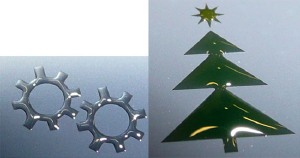May 25 2009
The doctoral dissertation of Lauri Sainiemi (M.Sc.) studies silicon micro and nanofabrication methods, which have a large number of applications. The single most interesting example presented in the dissertation is a novel nanopatterned silicon surface which allows almost limitless manipulation of water droplets.
Droplet shapes can be tailored freely, and the nanopatterned surface can be made completely water-repellent. On such a surface, a water droplet bounces like a tennis ball. The surface also enables splitting the droplets using only the surface forces. Sainiemi, who works at Micronova at the Helsinki University of Technology, uses these surfaces in material studies, in analytical applications, and in droplet microfluidics.

Nowadays, it is possible to fabricate different kinds of structures on silicon wafers, such as nanopillars less than 100 nanometers in diameter, 1 000 times thinner than a typical human hair. Sainiemi's dissertation presents two ways of fabricating nanopillars on silicon wafers.
New method allows hydrophilic and hydrophobic surfaces to be fabricated side by side
The surface chemistry of silicon nanopillars can be tuned by depositing a layer of some other material, such as silicon dioxide or Teflon-like fluoropolymer, on top of the pillars. A smooth silicon dioxide surface is hydrophilic. Therefore, a water droplet spreads easily on the surface, forming a thin and large puddle-like droplet on it. By contrast, Teflon-like polymers are hydrophobic or water-repellent, which makes a water droplet on a Teflon-like polymer layer ball-shaped, and it typically rolls easily off the surface.
'Nanostructuring the surface enhances its inherent hydrophilicity or hydrophobicity. Therefore nanopillars coated with silicon dioxide are extremely hydrophilic, whereas those coated with teflon-like polymer are ultrahydrophobic', the researcher explains.
The doctoral dissertation of Sainiemi presents the first method of easily fabricating extremely hydrophilic and ultrahydrophobic surfaces side by side (also published in Advanced Materials 20, 3453-3456, 2008). The figure shows droplets on a hydrophilic surface which is surrounded by an ultrahydrophobic surface. Therefore, the droplets follow the shape of the hydrophilic area accurately.
Hydrophobic surfaces applied to cars and buildings
'We are all familiar with dirt-repelling Teflon-coated frying pans. Lately, the rapid development of nanotechnologies has enabled the fabrication of novel hydrophilic and hydrophobic surfaces, and they are a hot research topic all over the world', Lauri Sainiemi says. 'Dirt-repelling coatings are becoming more common and they are already used for example in surfaces of cars, walls and statues. We will see more exotic applications, such as devices based on droplet microfluidics, realised in the near future.
Lauri Sainiemi's (M.Sc.) dissertation in the field of semiconductor technology, Cryogenic Deep Reactive Ion Etching of Silicon Micro and Nanostructures, will be presented for public examination in the Faculty of Electronics, Communications and Automation, in the Large Seminar Hall of Micronova at Helsinki University of Technology (address: Tietotie 3, Espoo, Finland) on 22 May 2009 at noon.
His opponent is Prof. Ole Hansen, Technical University of Denmark, and the custos is Prof. Pekka Kuivalainen, Helsinki University of Technology.
The dissertation is available online at: http://lib.tkk.fi/Diss/2009/isbn9789512298679/